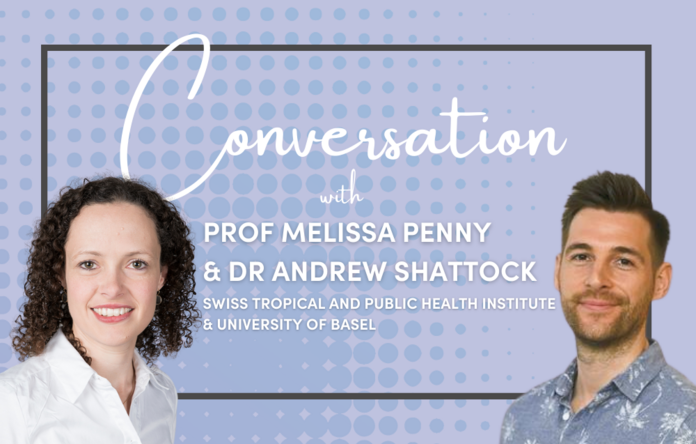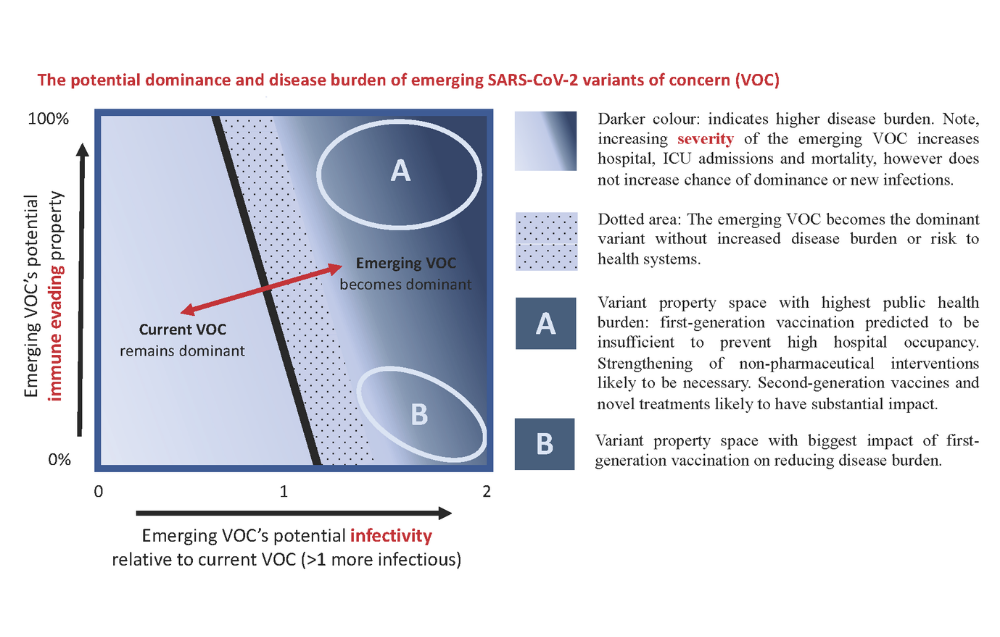
Prof Melissa Penny, Dr Andrew Shattock (Swiss Tropical and Public Health Institute, University of Basel) and colleagues have contributed to the understanding of SARS-CoV-2 dynamics and public health interventions for the pandemic. Their research has been relevant for the Swiss government and policy makers in other countries.
With a background in applied mathematics and public health, Prof Melissa Penny has long experience in modelling infectious diseases. At the Swiss Tropical and Public Health Institute (Swiss TPH), where she’s head of the Disease Modelling unit, a group of 22 researchers, she has been focusing on malaria for many years – developing analyses and different mathematical models to support product development and to assess vaccines and drugs for malaria.
A pandemic pivot
When SARS-CoV-2 emerged at the beginning of 2020, like other modelling scientists Melissa Penny and part of her team shifted their attention to COVID-19. She formed an especially close alliance with her colleague Dr Andrew Shattock from her unit at Swiss TPH. Dr Shattock, who has worked with more than 20 national governments on the control of HIV/AIDS, spent the early months of the pandemic collaborating with the European Centre for Disease Prevention and Control (ECDC) in Sweden.
Melissa Penny, on her part, became involved in the early stages of the Swiss National COVID-19 Science Taskforce, as a member of the data & modelling group. "Our first modelling steps were aimed at understanding the biology of the virus", says Penny, "but soon we turned to the dynamics of the disease itself, with data from the lab and from epidemiological studies."
In late 2020 and early 2021, one key scientific question the Swiss government turned to was the impact that vaccination against COVID-19 would have on the disease and hospitalisation burden of the pandemic, and how vaccination would possibly alter decisions on other, non-pharmaceutical interventions (NPIs) such as social distancing or the wearing of protective masks. In early 2021 Prof Penny conducted a study on this question* in close collaboration with Dr Shattock. They developed an individual-based transmission model of SARS-CoV-2 dynamics, comparing the impact of various vaccination and NPI strategies on the epidemic in Switzerland. "It was a key period in Switzerland ", Shattock says, "there was pressure to relax NPIs as vaccinations were only beginning to be rolled out." "Our findings stressed the importance of rapid vaccination scale up alongside a gradual relaxation of NPIs" says Penny. Their conclusion also confirmed that emerging viral variants of SARS-CoV-2 would have to be closely watched and responded to if public health officials wanted to keep control of the Swiss epidemic. The modelling was hence included in Cantonal documents as well as Taskforce documents.
New variants and the next twist
As so often happens in research, where answering one question leads to a brand new one, Penny and Shattock modelled the risk of new variants in a following study.* "The Delta variant was already present at that point", Penny recalls, "with Omicron increasing at the end of 2021." Engaging with the scientific community, the Swiss TPH team estimated the range of risks posed by Omicron or possible new variants, "depending on any change to disease severity with Omicron or new variants, or due to the variant’s ability to escape a person’s immune system, or if new variants have increased ability to transmit compared to Delta." In their paper* they concluded that "increasing vaccination is projected to have the biggest public health benefit for mitigating highly infectious, severe variants to which the immune system is able to respond." However, they also emphasized that variants not controlled by any previously gained immunity, even less severe ones, would require alternative measures for control.
This graphical summary of the research paper* Le Rutte et al. 2022 shows the interplay between the potential infectivity, immune evasion and severity of future SARS-CoV-2 variants of concern (VOC) on its chances of becoming the next dominant variant, its associated public health burden, and the potential impact of interventions. Credit: the Swiss TPH COVID-19 modelling team of the group of Prof Melissa Penny.
A turn yet again
Meanwhile, in September 2021, the dynamics of COVID-19 had changed yet again, and the question public health officials raised was: Which vaccination strategies should we recommend to people, with immunity waning and possibly more transmissible variants of concern emerging? Or, to put it more simply: "How often do we vaccinate? Is it once a year? Twice a year? Is it just the high-risk population – or everyone?" Those were the scenarios which Melissa Penny and her colleagues examined in fall 2022.* They found that the most optimal scenario to reduce hospitalisations was to have a "well-timed" booster once a year, meaning three to four months ahead of a winter peak, whether or not new variants of concern emerge. That conclusion applied not just to the high-risk population, but to everyone eligible for vaccination. "The rationale was to allow some additional population-level immunity with the booster", explains Melissa Penny, "which is what most of the governments have recommended." The results were also shared with the ECDC, with Dr Andrew Shattock collaborating and supporting the EU agency. "Our findings really highlighted the societal effect of low-risk individuals getting an annual booster. Boosting your own immunity helps to protect those most at risk" Dr Shattock says.
A final twist?
In 2023, SARS-CoV-2 may be loosening its grip on the world. Even so, COVID-19 doesn’t belong to the past for many people. Cue the next question for Melissa Penny’s BRCCH project to investigate: "Now we are looking at therapeutic interventions for COVID-19 ", she says, "modelling different scenarios. Which treatment is effective in addition to high vaccination coverage to support those at higher risk of severe disease and beneficial to save health system costs?"
The COVID-19 pandemic has been characterized by several twists and unexpected turns and as yet still unanswered questions remain. In a scenario where new variants of the virus might emerge in the future, it is certainly good to know which treatments and adapted vaccines could help, and it remains crucial to have the mathematical tools to support evidence on new questions.
Background
Professor Melissa Penny leads the Disease Modelling Research Unit in the Epidemiology and Public Health department at Swiss TPH and is currently an assistant professor at the University of Basel. She leads a BRCCH research project "Using Model-based Evidence to Optimise Medical Intervention Profiles and Disease Management Strategies for COVID-19 Control." Her work, and that of her colleague Dr Shattock, is part of the overarching progamme: BRCCH’s Fast Track Call for COVID-19 Research.
